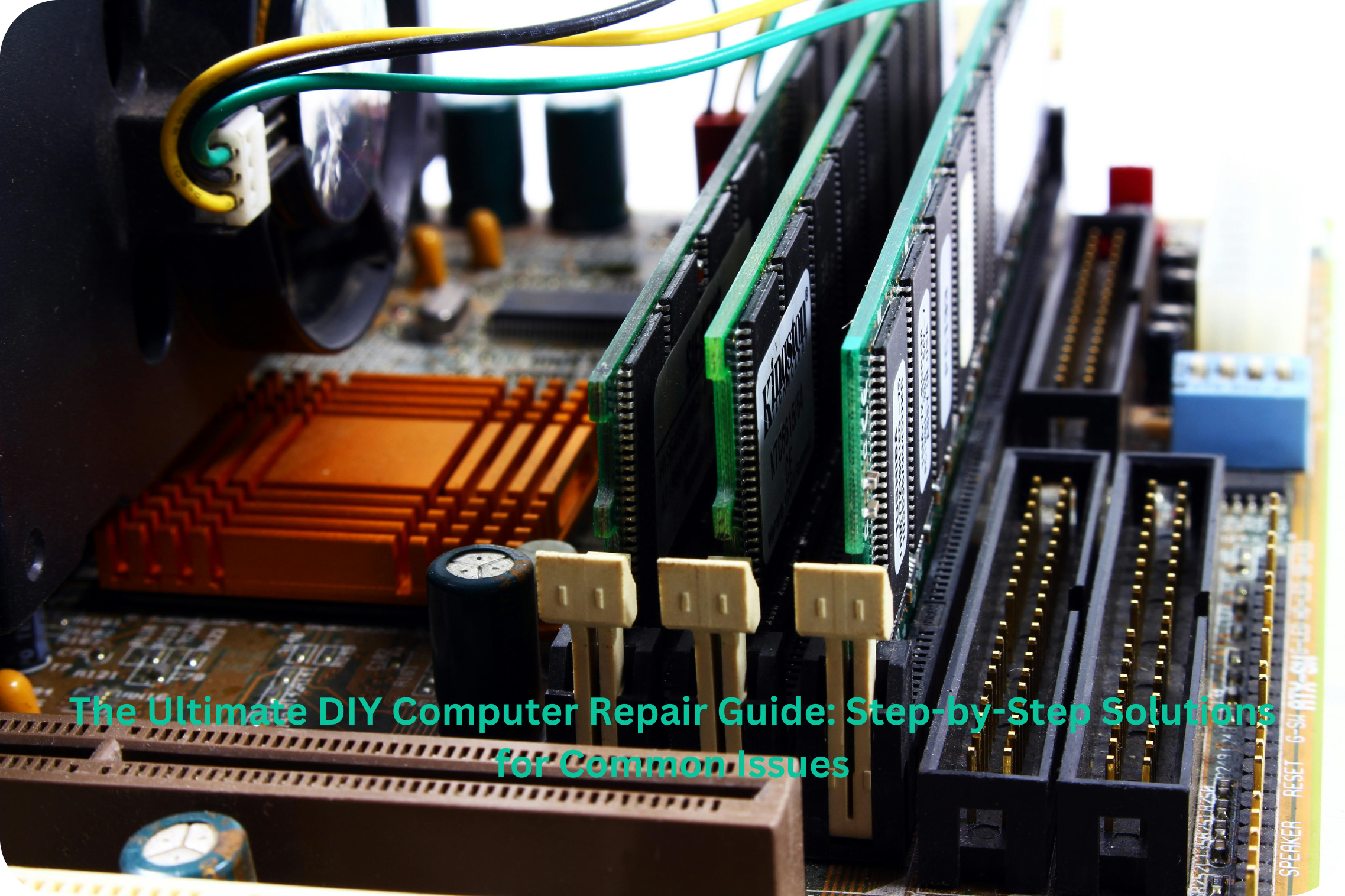Welcome to our comprehensive DIY computer repair guide! In this article, we will walk you through step-by-step solutions for common computer issues. Whether you’re dealing with a sluggish performance, software errors, or hardware malfunctions, our guide has got you covered. With easy-to-follow instructions and troubleshooting tips, you’ll be able to save time and money by fixing your computer issues yourself. So, roll up your sleeves and get ready to become your own computer repair expert!
Identifying Common Computer Issues
Before diving into the DIY computer repair process, it’s crucial to identify the underlying issues accurately. By understanding the symptoms, you can diagnose the problem correctly and apply the appropriate solutions. Here are some common computer issues you may encounter:
1. Slow Performance
A sluggish computer can be frustrating, especially when you need to get work done efficiently. Slow performance can be caused by various factors such as insufficient RAM, outdated software, or a cluttered hard drive. We’ll explore different ways to improve your computer’s speed in the upcoming sections.
2. Software Errors
Software errors can occur due to corrupt files, incompatible applications, or conflicts between different programs. These errors may lead to crashes, freezing, or unexpected behavior. We’ll guide you on how to troubleshoot and resolve these software-related issues effectively.
3. Hardware Malfunctions
Hardware malfunctions can range from faulty components to loose connections. Common hardware problems include a malfunctioning power supply, a failing hard drive, or a defective RAM module. We’ll help you diagnose these hardware issues and provide step-by-step instructions on how to fix or replace the faulty components.
4. Internet Connectivity Problems
Experiencing difficulty connecting to the internet or having a slow and unstable connection can hinder your online activities. We’ll tackle common internet connectivity problems and guide you through troubleshooting steps to get you back online swiftly.
Now that we have identified some common computer issues, let’s move on to the next section where we’ll delve into resolving these problems ourselves.
Resolving Common Computer Issues
Now that we have identified the common computer issues, let’s explore the step-by-step solutions to resolve them. Remember to follow these instructions carefully and proceed at your own risk.
1. Speeding Up a Slow Computer
If you’re dealing with a slow computer, there are several actions you can take to boost its performance:
- Remove unnecessary startup programs to reduce the load on your computer’s resources.
- Clear out temporary files and free up disk space by using the Disk Cleanup tool.
- Upgrade your RAM for improved multitasking capabilities.
- Defragment your hard drive to optimize file storage and retrieval.
- Consider upgrading to a solid-state drive (SSD) for faster data access speed.
2. Troubleshooting Software Errors
When dealing with software errors, follow these steps to resolve them:
- Update your software and operating system to the latest versions to fix any known bugs or compatibility issues.
- Perform a malware scan using reliable antivirus software to check for any malicious programs that may be causing errors.
- Use the Windows Event Viewer or system logs on other operating systems to identify error codes and messages for further troubleshooting.
- Consider reinstalling or repairing the software application if the errors persist.
3. Fixing Hardware Malfunctions
To fix hardware malfunctions, follow these guidelines:
- Check all cable connections to ensure they are secure and properly plugged in.
- Run hardware diagnostics tools to identify any faulty components.
- If a specific hardware component is causing issues, consider replacing it with a new one.
- Refer to the manufacturer’s documentation or online resources for detailed instructions on troubleshooting specific hardware problems.
4. Troubleshooting Internet Connectivity Problems
If you’re experiencing internet connectivity issues, try these troubleshooting steps:
- Restart your router and modem to refresh the connection.
- Check your network cables and ensure they are properly connected.
- Update your router’s firmware to the latest version.
- Reset network settings on your computer or device and reconnect to the network.
- Contact your internet service provider (ISP) if the problem persists to ensure there are no issues on their end.
By following these step-by-step solutions, you’ll be well on your way to resolving common computer issues on your own. In the next section, we’ll provide some additional tips to help you maintain a healthy and efficient computer system.
Maintaining a Healthy Computer System
Once you’ve resolved the immediate computer issues, it’s important to adopt good practices to keep your system running smoothly. Here are some tips for maintaining a healthy computer:
1. Regularly Update Software and Drivers
Keep your operating system, software applications, and drivers up to date. Regular updates often include bug fixes, security patches, and performance improvements, ensuring your computer functions optimally.
2. Practice Safe Browsing Habits
Avoid clicking on suspicious links or downloading files from untrusted sources. Install a reliable antivirus software and enable its web protection features to safeguard against malware and phishing attempts.
3. Back Up Your Data
Regularly back up your important files and documents to an external hard drive, cloud storage, or a combination of both. This precautionary measure ensures that your data remains safe in case of hardware failure or accidental deletion.
4. Clean and Dust Your Computer
Prevent overheating and hardware damage by cleaning your computer’s internal components. Use compressed air to remove dust from the fans, vents, and heat sinks. Ensure your computer is turned off and unplugged before performing any cleaning.
5. Optimize Startup Programs
Review the programs that launch automatically when you start your computer. Disable unnecessary startup programs to improve boot times and reduce the strain on system resources.
6. Manage Disk Space
Regularly check your hard drive’s available space and remove unnecessary files. Consider using disk cleanup tools or disk space analyzer software to identify and delete large or redundant files.
7. Use Surge Protectors
Protect your computer from power surges and voltage fluctuations by using surge protectors or uninterruptible power supplies (UPS). These devices can prevent damage to your computer caused by sudden power spikes.
By following these maintenance tips, you can extend the lifespan of your computer and enjoy a hassle-free computing experience. In the final section, we’ll provide additional resources and recommendations to further enhance your DIY computer repair skills.
Additional Resources and Recommendations
Now that you’ve learned how to tackle common computer issues and maintain a healthy system, here are some additional resources and recommendations to further enhance your DIY computer repair skills:
1. Online Forums and Communities
Join online forums and communities dedicated to computer repair and troubleshooting. These platforms provide a wealth of knowledge and support from experienced individuals who can help you with specific issues or answer your questions.
2. Video Tutorials and Online Courses
Explore video tutorials and online courses that focus on computer repair and maintenance. Platforms like YouTube, Udemy, and Coursera offer a wide range of instructional videos and courses, allowing you to learn at your own pace.
3. Manufacturer Documentation and Support
Refer to the documentation and support resources provided by your computer’s manufacturer. They often offer detailed guides and troubleshooting steps specific to their products, helping you address any hardware or software issues.
4. Regular System Scans and Maintenance
Perform regular system scans using antivirus software to detect and remove any potential threats. Additionally, schedule periodic maintenance tasks such as disk cleanup, disk defragmentation, and system updates to keep your computer running smoothly.
5. Professional Assistance
If you encounter complex or hardware-related issues that are beyond your expertise, don’t hesitate to seek professional assistance. Computer repair technicians can diagnose and resolve intricate problems, ensuring your computer is back up and running efficiently.
By utilizing these additional resources and recommendations, you can continue to expand your knowledge and skills in the realm of DIY computer repair. Remember, practice makes perfect, so don’t be afraid to dive in and gain hands-on experience.
Conclusion
Congratulations! You have now completed our comprehensive DIY computer repair guide. By following the step-by-step solutions provided for common computer issues, you can save time and money by resolving problems on your own.
Remember, identifying the root cause of the issue is essential before attempting any repairs. Take precautions, follow instructions carefully, and proceed at your own risk. If you feel uncomfortable or unsure about any step, it’s always best to seek professional assistance.
Additionally, maintaining a healthy computer system through regular updates, safe browsing habits, data backups, and proper cleaning will help prevent future issues and keep your computer running smoothly.
We hope this guide has empowered you to become more confident in handling your own computer repairs. Remember that practice and continuous learning will further enhance your skills in troubleshooting and maintaining your computer.
Thank you for reading our DIY computer repair guide. If you found it helpful, feel free to share it with others who may benefit from it. Happy repairing!
In conclusion, our comprehensive DIY computer repair guide has equipped you with the knowledge and skills to tackle common computer issues. By following the step-by-step solutions and maintenance tips provided, you can save time, money, and the hassle of taking your computer to a repair shop.
Remember to approach repairs with caution and carefully follow instructions. If you’re unsure or uncomfortable with any step, it’s always best to seek professional assistance to avoid further damage.
By maintaining a healthy computer system and practicing safe browsing habits, you can prevent future issues and ensure your computer operates at its best. Regular updates, data backups, and proper cleaning will go a long way in keeping your system running smoothly.
We hope our DIY computer repair guide has been valuable to you. Feel free to share it with others who may benefit from it. Empower yourself with the skills to resolve computer issues and enjoy a seamless computing experience!

